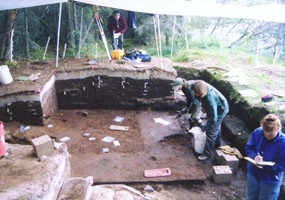
River area. Archeologists study the material remains of the past. Their work at Katmai is fascinating, but it can also be frustrating. Many aspects of the complex technologies of prehistoric people, such as nets, clothing, footwear, and baskets are not preserved in the acidic soils here. More mysterious still are the equally complex spiritual, social and political practices of past communities. Some of these will remain ever shrouded in the past, but others can be revealed through careful, meticulous study and research. 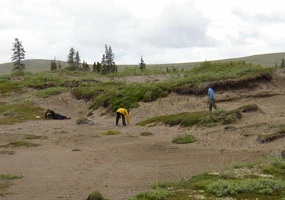
tradition site in Katmai National Park. The Paleoarctic Tradition – 9,000 to 7,000 years ago The oldest sites in Katmai belong to the Paleoarctic tradition. The tradition is found across Alaska, mostly at sites that were not ice-bound during the last glacial period (26,000 to 14,000 years ago). Paleoarctic collections are similar to earlier collections from northeast Asia, meaning that Paleoarctic people probably originally crossed the land bridge by foot or the widening Bering Strait by boat. 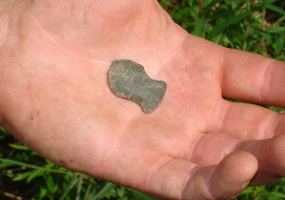
are typical of the Northern Archaic tradition. The Northern Archaic Tradition – 5,000 to 3,850 years ago Northern Archaic tradition artifact collections are similar to earlier collections from Canada, meaning that people who had originally developed forest-adapted lifeways further south were probably moving back up north as the forests spread during the warm period from 10,000 to 5,000 years ago (the hypsithermal). They were still living in small, mobile camps following game and other resources. Northern Archaic sites are not numerous, but are geographically widespread, occurring across Alaska and northern Canada.
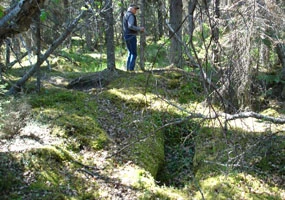
remains of an Arctic Small Tool tradition house in the Brooks River area. The Arctic Small Tool Tradition – 3,850 to 3,000 years ago Arctic Small Tool Tradition sites are found across Alaska and the Canadian North. In Katmai, though, Arctic Small Tool communities in the Naknek drainage had neighbors on the coast with a different cultural pattern. As the name implies, the people of this time used small, finely chipped stone tools. They also lived in the earliest semi-subterranean houses (as opposed to campsite shelters) that archeologists have found in the Katmai area. Artifact collections from the coast are more similar to Kachemak phase collections from Kodiak Island.
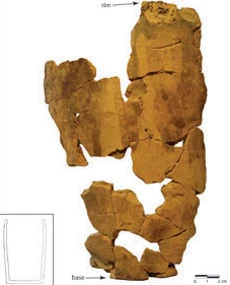
a site along the Alagnak River. The Norton Tradition – 2,250 to 900 years ago Norton tradition sites are found across coastal Alaska, and in a few places in the interior. Ceramic manufacturing, a technology ancient Alaskans probably learned from their Asian neighbors across the Bering Strait, appears during the Norton tradition. This is the first time period in which the same people seem to be occupying the Katmai coast and the Naknek drainage. Communities at this time were becoming more settled, although people still moved seasonally to camps. Permanent villages were not year-round. People built the labor-intensive houses, then returned to them seasonally every year (as opposed to making new temporary camps every year or few years). Norton people are the first to intensively harvest salmon runs. 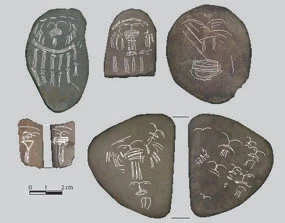
found at a site in the Brooks River area, might be game pieces or ritual items (incising enhanced). The Thule Tradition – 900 years ago to historic contact Around 1,000 years ago, a major change in lifeways swept across Alaska and the Canadian arctic. This was the Thule migration, during which people brought a sea mammal-hunting culture from western Alaska eastward as far as Greenland. Some archeologists think that the success of Thule people was due to falling temperatures which increased the pack ice, from which sea mammals are typically hunted. From the coasts, they spread inland, bearing artifacts of ground slate and building large semi-subterranean houses. Thule sites are found across the Katmai region. 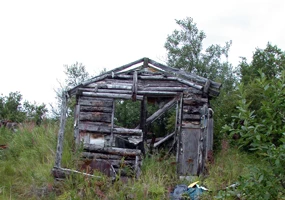
on the Nonvianuk River. Historic Era Sites Remains more than 50 years old are eligible to be considered archeological sites. Cabins, camps, caches, military sites, and canneries are among the historic sites found in the Katmai area. If you encounter an archeological or historic site, please enjoy exploring it! But resist the temptation to take anything with you. Not only is removing artifacts a violation of federal law, it prevents others from experiencing our shared history. You can help protect our heritage! |
Last updated: February 7, 2022
